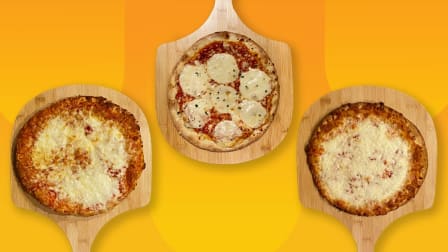Hunger Crisis: 1 in 5 Americans Turning to Food Banks
A new CR survey reveals a growing food-insecurity problem, with people of color disproportionately affected

Shaunté LeSure had never needed help feeding her family. But shortly after the pandemic struck last spring, the Selma, Ala., native lost her job recruiting health aides for nursing homes. As her income stalled, LeSure realized that she might not be able to get enough food for herself and her elderly father, whom she lives with and cares for.
So, for the first time in her 42 years, she accepted free boxes of meat, dairy products, cheese, fresh fruit, and veggies in a drive-through food-assistance program offered through her church. “That box was a lifesaver,” LeSure recalls.
LeSure is just one of many Americans who, in the midst of a pandemic that has devastated the health and finances of millions, have had to rely on charity to feed themselves and their families.
A new nationally representative survey of more than 2,000 U.S. adults by Consumer Reports finds that about 1 in 5 American grocery shoppers (19 percent) have used a food pantry, food bank, or community food distribution at some point since the pandemic began. What's more, about half of them said they didn’t use these food programs in the year leading up to the COVID-19 outbreak in the U.S.
What the Food Pantries Are Seeing
At Feeding America, the largest hunger-relief not-for-profit in the U.S., 40 percent of visitors between March and June 2020 were new, says Katie Fitzgerald, Feeding America's executive vice president and chief operating officer. That influx into its 200 food banks has contributed to a 60 percent, year-over-year increase in total food bank visitors as of August 2020, she says. That number has stayed steady through the eight months of the pandemic. “We’d hoped to see that average number decrease, but it’s still about 60 percent,” Fitzgerald says.
Feeding America estimates that this year, stresses from the pandemic could result in 50 million Americans, including 17 million children, being food insecure—lacking reliable access to an adequate amount of affordable, nutritious food.
At the Good Shepherd Food Bank in Auburn, Maine, workers have seen new faces and have tried to make them feel welcome. “For people coming for the first time, their initial reaction is to apologize,” says Kristin Miale, the organization’s president. “They say, ‘I’m sorry I’m here, I never thought I’d have to be here.’ The people who volunteer will always respond, ‘You don’t need to apologize. It's not your fault.’”
Good Shepherd supplies food to more than 500 community-based programs throughout Maine. Due to the pandemic, the organization has seen a 7 percent increase in visitors who own their homes. “It’s a higher income than was typical prior to COVID,” Miale says. “It’s people who never before had to seek out food assistance.”
In Peoria, Ill., a social-services provider called Neighborhood House used to manage a supplemental food program that served meals to 45 elderly people and people with disabilities prior to the pandemic. Today it serves 428, a rise of almost 1,000 percent, says CEO Becky Rossman. Another of the organization’s programs provided dinner and a snack to about 60 teens. Now? It’s feeding 235 kids—and their families. Because those kids are no longer in school—or eating meals at Neighborhood House after school—the charity has had to invest in two trucks to make home food deliveries. “When a lot of these kids are not in school, they don’t eat,” Rossman says.
“For people coming for the first time, their initial reaction is to apologize. They say, ‘I’m sorry I’m here, I never thought I’d have to be here.’”
President, Good Shepherd Food Bank, Auburn, Maine
LeSure ended up using her church’s food assistance for about a month, until she was able to start working again. Though the church is closed for in-person worship, she says she and her pastor have been talking recently about starting a program to provide dinner there two days a week when it reopens, for families who are still struggling.
“It was very humbling to go through this myself,” LeSure says. “You think you have it together, but then something happens that you have no control over. It lets you see people in a different light. And some people can’t bounce back from this.”
Food Pantries Are Pinched by Higher Prices
Food banks and pantries don’t get all their food from donations. When they have to buy it, they can get better prices than consumers because they buy in bulk and don’t pay sales tax. But food prices have gone up for nonprofits, just as they have for regular folks.
Miale, of the Good Shepherd Food Bank, says her cost per pound of food—a general measure that encompasses a whole spectrum of foods—has gone to $1.10 per pound from a pre-pandemic 87 cents. That’s a 26 percent increase.
And there are other associated costs. “We’re moving so much more food, and we’re also using more forklifts, boxes, tape, electricity,” says Feeding America’s Fitzgerald. “All those costs have gone up.”
Those extra expenses create all the more stress for food banks and pantries facing shortfalls in funding. “Our normal donor base has given to its capacity,” says Rossman of Neighborhood House. “Some of my board members have been furloughed. These are professionals in the community above middle class, and they are getting crunched, too.”
Concern for What Lies Ahead
As the colder weather approaches and COVID-19 infections continue to rise across the country, food-assistance charities are working to adjust to even greater need. “Food insecurity gets worse in winter,” says Fitzgerald, of Feeding America. “When people have to choose between paying their utilities and food, they’ll skimp on their food budget.”
To keep providing food to those in need during a time when the pandemic is likely to get worse, Fitzgerald says her organization has purchased about 30 percent more food in the fiscal year ending in June 2020 than it did in the same period a year earlier. And food pantries in her network will be doing more door-to-door deliveries.
Charities say they continue to see generosity in the form of volunteer work, food, and money, which they hope will last beyond the traditional holiday season. But solving food insecurity is a problem of a much bigger scale than what they can handle.
For example, for every meal that charities provide, the federal government’s Supplemental Nutrition and Assistance Program (SNAP) provides nine meals, says Luis Guardia, president of the Food Research and Action Center, an anti-poverty and anti-hunger research and advocacy organization based in Washington, D.C. “It’s great that charitable groups have stepped in as well as they can,” Guardia says. “But to deal with a hunger crisis of this magnitude, charities can’t do it alone.”
What You Can Do
Whether you need help getting food for your family or you want to offer help to those in need, here’s what you can do.
If You Need Food Assistance
• Check your eligibility for SNAP. Hunger-relief experts say people often are surprised to find they’re candidates for the federal Supplemental Nutrition and Assistance Program (SNAP). Feeding America has a list of other food-assistance programs for which you may qualify.
• Visit your local food bank, pantry, or distribution center. To find one near you, type in your ZIP code on the websites of Feeding America, Meals on Wheels America, WhyHunger, or other hunger-relief organizations (major groups are mentioned on the U.S. Department of Agriculture website). Or check on your county’s social services website. Religious organizations near you may offer food programs as well.
• Don’t be shy. Tell the rep at the food pantry which foods you can’t eat, and which you’d like to have more of. Food-assistance programs say that even when they pre-package food for no-touch takeaway and delivery, they still try to accommodate both dietary requirements and preferences.
• Consider healthy options. Pick protein-rich foods like meat, chicken, fish, nut butters, and legumes. If you can, choose whole grains such as brown rice and 100 percent whole-wheat bread, rather than refined grains such as white bread or saltines. Fresh fruits and vegetables are great when they’re available. But even canned fruit cocktail is a better snack choice than a bag of chips.
• Mention other help you may need. Let the rep know about other issues you’re worried about—for instance, paying your utility bill. Food banks are plugged into a community’s resources and can refer you to other avenues of help.
If You Can Help Those in Need
• Volunteer at your local food bank. With the increase in clients, food banks and pantries need more help than ever. In terms of safety precautions, food banks we spoke to adhere to CDC mask and social-distancing guidelines. You can also do jobs that don’t require entering a food pantry facility, such as delivering food directly to a person’s doorstep.
• Prioritize cash over cans. Food banks welcome most donated food, but monetary donations may have a bigger impact because food banks can buy food wholesale and in bulk, and as not-for-profits, they don’t pay sales tax.
• Donate protein-rich, shelf-stable goods. If you prefer to donate food, ask the charity what foods and other goods it needs; there may be a list posted on the group’s website. In general, choose healthy items like canned beans, tuna and chicken, nut butters, whole-grain pastas, and shelf-stable milk. To stretch your dollar, look for those items when they’re on sale and buy extra to donate.
• Choose a charity that doesn’t waste money. Effective charities devote much more of their operating budget to the services they provide than on their other expenditures, such as salaries and marketing costs. Find a charity that does a good job on Charity Navigator or the Better Business Bureau’s Wise Giving Alliance.
• Call your senator. Advocate for passage of the Health and Economic Recovery Omnibus Emergency Solutions (HEROES) Act, which was passed in the House in May. The bill would expand the federal government’s Supplemental Nutrition and Assistance Program (SNAP) program, which hunger-relief advocates say is the federal government’s chief and most powerful means of providing hunger assistance.




















